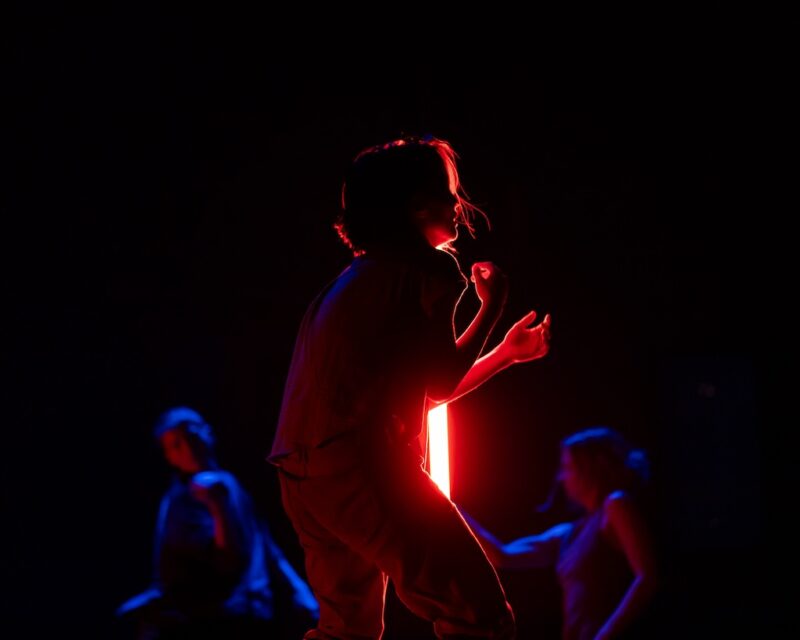Presence in Absentia: In her newest exhibit, Baltimore painter Jo Smail skewers the typical relationship between object and background—with a pair of scissors.
by Cara Ober
Degrees of Absence, a new exhibit at Goya Contemporary by Jo Smail, belies its title. Despite the painter’s use of wide swaths of raw canvas in her compositions, a new and insouciant trick, Smail’s abstract canvasses are imbued with a palpable sense of presence. Instead of exploring quiet emotional states and places as she has in past series, Smail’s newest works are populated with figures and animals, rendered in the krunky, primitive, poetic style that the artist has developed over many years. Even Smail’s series of small digital photographs, embellished with collage, conjure up the intimate presence of the artist and her collaborators on the project.
If you are not familiar with Smail’s work, it may take some time to get acquainted. Her paintings are disarmingly simple. The artist has made a career of breaking the sacred tenets of painting with impunity. Under Smail’s hands, assumptions about craftsmanship, taste, and depiction are trampled on, to varying effect. This big-eyed and probing manner of working has endeared her to generations of abstract painters, especially at the Maryland Institute College of Art, where many of her students emulate her with limited success. Although Smail herself describes her studio practice as a naughty pleasure, she’s logged in decades of investigation into her modus operandi of choice. Over the years, Smail has developed a system of purposeful play, as well as the restraint and editing skills to balance it, that comes only from making mistakes in the studio and learning from them. Degrees of Absence is an example of a seasoned artist in her prime, someone determined to push beyond previous comfort zones into unchartered areas, while enjoying herself tremendously.
In her newest works, Smail skewers the typical relationship between object and background, quite literally, with a pair of scissors. Instead of painting her “figures” into the picture plane, Smail cuts out the successful parts of old paintings and glues them onto new canvasses, creating figures in relief. In Scent of Melons, a characteristic Smail squiggle of black transforms into the edges of a cartoon-shaped figure. Up close, a scumble of purple, black, and red layer together into a cohesive jumble, reinforced by the literal edge of the shape, which creates a tiny shadow. Glued onto the canvas, the large shape dominates the composition, with a demure white square receding behind it. Visually, it makes no sense, but it feels right on a visceral level. In Room to Let, a smaller canvas, Smail applies similar tricks, positioning several layers of glued canvas onto a raw background. Rather than creating the illusion of depth, Smail contrasts the flatness of the painting physically, building it up with layers of canvas and three-dimensional blobs of white paint resembling polka dots. The result is a bit silly and jarring, but in a delightful “Why didn’t I think of that?” kind of a way. Where other painters would call this a failed experiment, Smail manages to prevail.
Another sacrosanct tradition of painting Smail profanes in her newest exhibit is in the boundaries of her canvasses. Numerous large works include “baby paintings” attached to their edges, like an apostrophe or a small tumor. Broken and Off depicts a lumpy camel-shaped blob, covered in a simple red and orange plaid pattern. It would appear to be headless, except for the tiny canvas attached to its lower right side. The red and orange pattern continues on the smaller canvas, just below where a head should be, advancing the figure out, onto the wall. In Figure in Stripes Bird Watching, the baby painting is positioned diagonally at the top right corner. The striped figure appears to be gazing up at the smaller canvas, which doesn’t exactly resemble a bird, but it reminds you of one anyway. In both cases, the baby paintings awkwardly violate the edge of the canvas and force the viewer to make a decision: Do you reject these silly little appendages or love them? If you love them, you have joined the ranks of Smail admirers.
In the smaller, back gallery, Smail’s work takes a strange turn. Instead of paintings, several walls are filled with digital photographs printed on rag paper, like tiny etchings. On a recent trip to Florence, Smail couldn’t resist documenting the crumbling, painted-over walls, the centuries-old cobblestones, fading floors of churches, and the recent graffiti that adorns it all. Much like Smail’s paintings, her photographs capture color contrasts between subtle and bold, and flat surfaces accented by compositional marks along the edges. While a logical augmentation to the paintings in the show, the photographs don’t add anything to it—until you realize Smail is breaking the picture plane here, too. The series is simply titled Public/Private, and each digital photograph is hand embellished with sewed-on buttons, bits of bead and lace, paper, string, and other small accoutrements from an old sewing kit. According to Smail, all the items were inherited from her mother and grandmother, and as “I glue, patch, measure, mark, decorate, fasten, mimic, pin, stitch, and recycle … I smile, dedicate, and remember.” As with her paintings, Smail’s additive musings imbue each print with a substantial sense of presence and seem completely wrong from a logical standpoint, but successfully knit together into odd and intimate moments.
In Degrees of Absence, Jo Smail continues a long-time trajectory where she often manages to capture ephemeral modes of thinking and non-thinking, moments which can’t be described, but experienced in present tense. It’s a rawness that exists somewhere between silence and expression, and this state is not logical, efficient, or common in daily life. For this reason, Smail’s work can come off like an unfamiliar system of language, simultaneously vexing and charming, initially off-putting, but inviting, too, in the very best sort of way.
Jo Smail: Degrees of Absence will be on view at Goya Contemporary through the end of February.






